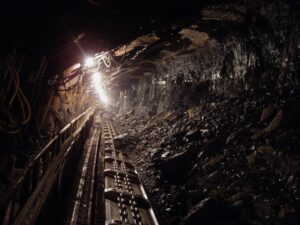Mining, Money and Memories
BY ISAIAH FRIZZELL

In Sun Valley, if you pick a direction, point and follow the line, you’re bound to find a mine. Most of America is similar and within that is a wild, wonderful history that speaks to the indomitable spirit of the pioneers and our ancestors who forged this country from raw elements with pure will.
Wagon Days and How
It’s almost time for Wagon Days—the annual event in Ketchum celebrating the past mining history Sun Valley was founded on. While Sun Valley Resort gets a lot of much-deserved press for bringing people to the Valley, the founders were miners and settlers in the cottage industries that followed them through this expanse. In the spirit of celebration, we seek to remember and access some faint part of our historical lineage in events such as Wagon Days, or even a Renaissance Faire.
We have photos from the late 19th and early 20th century to help get the tone of fashion and technology that decorated and drove that mining period. It’s bizarre to note that technology has always driven fashion and society. The sewing machine, weaving loom, even scissors at one time were not in use because they didn’t exist. As these machines evolved, so did fabrication of fabric and style of wear based on availability and desired fit for the occasion. ‘Out of wool trousers, eh? What have you got in cotton?’ You most definitely weren’t wearing silk to put in your day at the mine.
The Wagon Days Big Hitch Parade is one of the largest nonmotorized parades in the country and each year around 15,000 people visit Ketchum to experience it. The historically accurate vehicles—carriages, buggies, wagons, carts, stagecoaches—are the draw and, in specific, the Lewis Fast Freight Ore Wagons are the finale as they were made specifically with a wheelbase measured for the Trail Creek Summit road. (ketchumura.com)
LARPing
Many living now may still remember the look and feel of the culture surrounding the mines in an ephemeral but deeply felt sense. How much has actually changed? Again, a type of genetic memory, largely deriving from culture—television, photos and maybe some stories from grandma and grandpa. These disparate images all combine to make memories in the mind that resonate when the real thing is seen in life.
This is one reason why we, as a people, do reenactments. In modern speak, it’s called LARP (Live Action Role Play) and is often the butt of a joke or meme—for when someone is trying too hard to act like a professional or expert but without the actual experience and training—like an overzealous but poorly performing cook or scientist. In our reality, actual LARPing is a form of memory entrainment that allows us to visually and audibly, as a group, understand the way an historic people might act or a fictional group may function. Acting out the roles is a strong way to build group memory. What are movies and plays if not mementos meant for reflection?
Pioneers, miners, and settlers all dressed and acted much like we do now and when extrapolating further back it’s easy to see that people may have never been much different from how we are now. The clothes and slang have changed but people’s needs and desires remain the same. Perhaps the one thing that has dramatically changed is people’s ability to retain focus and concentrate without the tumultuous distractions of the small, black, glass box we all carry everywhere to talk to, listen to and stare at—constantly, aimlessly replacing whatever thought or image was in our mind with something else, quick, anything else.
The reenactments at Wagon Days are a whimsical, entertaining memory maker that educates viewers in a historical notion of how this set of ancestors carried themselves. How would we recreate the actual mines? Perhaps feasibly with virtual reality but to do it as set dressing for the reenactment would require elaborate building. We may have to mimic some of the mines themselves.
Sun Valley’s Mines
The Yankee Fork Mines, Triumph Mine, Parker Mine, Minnie Moore Mine and the North Star Mine were five of the principal ore clutches that established Sun Valley.
The Yankee Fork Mines, while not directly in Sun Valley, were at the core of what was known as the Yankee Fork Gold Mining District. Most settlers to this region were brought about by the great California Gold Rush of 1848. When we became the Idaho Territory, in 1863, many fortunes had already been made and settlers or prospectors were looking for more gold and silver. They found it at Yankee Fork and the Custer and Bonanza mines brought many to the general area.
The Triumph mine, near Ketchum, was discovered in 1884. It was well known for its silver, lead, and zinc deposits. Operating until the mid-20th century, the mine generated the wealth that established central Sun Valley. (www.idahogeology.org)
The Parker mine, seven miles north of Ketchum, led to the settling of Hailey. It sat at 7,100 feet and produced over 1 million tons of lead and over 300,000 ounces of silver. (westernmininghistory.com)
The Minnie Moore mine produced lead and silver in greater quantities than its peers in the area. This put Bellevue on the map. (idahogenealogy.com)
The North Star mine, also near Ketchum, while not a massive producer of silver, brought sphalerite, galena, and antimony, with the waste consisting of calcite, pyrite, and quartz. Gemhounds, rejoice! (thediggings.com)
Mining Memories
How would we recreate these geological spots for edification on the ways of the miners? That might be an actual good use of digital painting, but to do so IRL (in real life) would require meticulous geological stratification, extreme engineering and artistry to safely recreate the mines for a reenactment. It sure would be fun to watch! In the meantime, Wagon Days approaches so it’s as good of a time as any to start talking about the mines and bring them up from the memory banks.